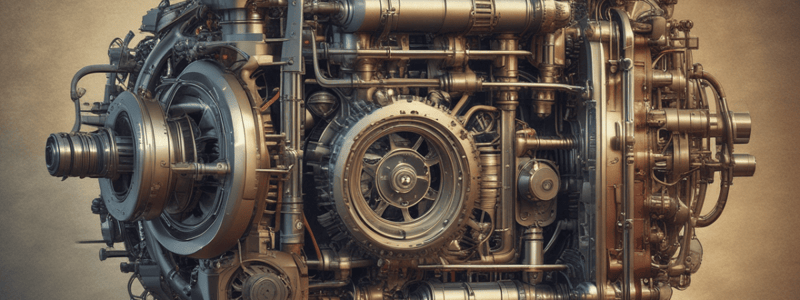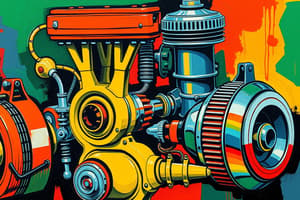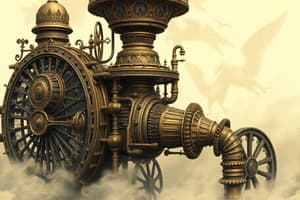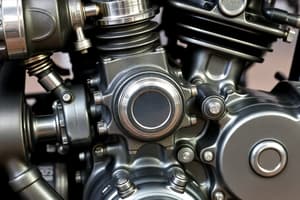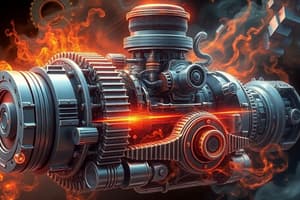Podcast
Questions and Answers
What is one of the approximations made for the thermodynamic analysis of internal combustion engines?
What is one of the approximations made for the thermodynamic analysis of internal combustion engines?
- The combustion process is replaced by an equivalent energy addition process from an external source (correct)
- The air is assumed to behave like a real gas
- The engine is assumed to operate on an open cycle
- The engine is assumed to be a perfect converter of energy
What is the name of the inventor of the Air Standard Otto cycle?
What is the name of the inventor of the Air Standard Otto cycle?
- James Watt
- Nikolaus A. Diesel
- Rudolph Diesel
- Nikolaus A. Otto (correct)
What is the process during which a mixture of fuel vapour and air is drawn into the cylinder in the Otto cycle?
What is the process during which a mixture of fuel vapour and air is drawn into the cylinder in the Otto cycle?
- Expression
- Constant pressure suction (correct)
- Compression
- Constant volume combustion
What happens to the temperature of the gas during the compression process in the Otto cycle?
What happens to the temperature of the gas during the compression process in the Otto cycle?
Why do we need to consider only the cycle 1-2-3-4 for thermodynamic analysis of the Otto cycle?
Why do we need to consider only the cycle 1-2-3-4 for thermodynamic analysis of the Otto cycle?
What type of gas is the air assumed to behave like in the air standard cycle?
What type of gas is the air assumed to behave like in the air standard cycle?
What is the name of the cycle that models the operation of a spark-ignition internal combustion engine?
What is the name of the cycle that models the operation of a spark-ignition internal combustion engine?
What is the purpose of the air standard cycle?
What is the purpose of the air standard cycle?
What is the main assumption in the ideal Otto cycle?
What is the main assumption in the ideal Otto cycle?
What is the formula for the efficiency of the Otto cycle?
What is the formula for the efficiency of the Otto cycle?
What is the main difference between the Otto and Diesel cycles?
What is the main difference between the Otto and Diesel cycles?
What is the formula for the heat input in the Otto cycle?
What is the formula for the heat input in the Otto cycle?
What is the advantage of the Diesel cycle over the Otto cycle?
What is the advantage of the Diesel cycle over the Otto cycle?
What is the formula for the efficiency of the Diesel cycle?
What is the formula for the efficiency of the Diesel cycle?
What is the term for the ratio of the specific heat capacities in the ideal cycle?
What is the term for the ratio of the specific heat capacities in the ideal cycle?
What is the Dual Cycle also known as?
What is the Dual Cycle also known as?
What is the primary difference between the Dual Cycle and the Otto cycle?
What is the primary difference between the Dual Cycle and the Otto cycle?
What is the assumption made about heat transfer during the compression and expansion strokes in the Dual Cycle?
What is the assumption made about heat transfer during the compression and expansion strokes in the Dual Cycle?
What is the equation that represents the efficiency of the Dual Cycle?
What is the equation that represents the efficiency of the Dual Cycle?
What is the process that occurs between points 2 and 3 in the Brayton cycle?
What is the process that occurs between points 2 and 3 in the Brayton cycle?
What is the assumption made about gas behavior in the Brayton cycle?
What is the assumption made about gas behavior in the Brayton cycle?
What is the equation that represents the efficiency of the Brayton cycle?
What is the equation that represents the efficiency of the Brayton cycle?
What is the primary application of the Brayton cycle?
What is the primary application of the Brayton cycle?
What is the difference between the Dual Cycle and the Diesel cycle?
What is the difference between the Dual Cycle and the Diesel cycle?
What is the main advantage of the isobaric heat addition process in the Brayton cycle?
What is the main advantage of the isobaric heat addition process in the Brayton cycle?
What is the assumption made in the Joule cycle regarding heat transfer during compression and expansion strokes?
What is the assumption made in the Joule cycle regarding heat transfer during compression and expansion strokes?
What is the expression for the efficiency of the Joule cycle in terms of the pressure ratio (PR) and the temperature ratio (TR)?
What is the expression for the efficiency of the Joule cycle in terms of the pressure ratio (PR) and the temperature ratio (TR)?
Which cycle has the highest efficiency and work output for the same maximum pressure and temperature?
Which cycle has the highest efficiency and work output for the same maximum pressure and temperature?
What is the primary difference between the Rankine cycle and the Modified Rankine Cycle?
What is the primary difference between the Rankine cycle and the Modified Rankine Cycle?
What is the main limitation of the efficiency of the Rankine cycle?
What is the main limitation of the efficiency of the Rankine cycle?
What is the purpose of the isentropic expansion process in the Joule cycle?
What is the purpose of the isentropic expansion process in the Joule cycle?
Which cycle has a lower mean effective pressure (MEP) and work output compared to the diesel cycle?
Which cycle has a lower mean effective pressure (MEP) and work output compared to the diesel cycle?
What is the purpose of the reheat process in the Modified Rankine Cycle?
What is the purpose of the reheat process in the Modified Rankine Cycle?
What is the expression for the work done in the Joule cycle?
What is the expression for the work done in the Joule cycle?
What is the characteristic that makes the Carnot cycle an ideal cycle?
What is the characteristic that makes the Carnot cycle an ideal cycle?
What is the primary advantage of the Modified Rankine Cycle over the Rankine cycle?
What is the primary advantage of the Modified Rankine Cycle over the Rankine cycle?
What is the main difference between the Joule cycle and the Otto cycle?
What is the main difference between the Joule cycle and the Otto cycle?
What is the formula for the maximum possible efficiency of a heat engine?
What is the formula for the maximum possible efficiency of a heat engine?
What is the purpose of the regeneration process in the Modified Rankine Cycle?
What is the purpose of the regeneration process in the Modified Rankine Cycle?
What is the characteristic that makes the Rankine cycle more practical than the Carnot cycle?
What is the characteristic that makes the Rankine cycle more practical than the Carnot cycle?
Flashcards are hidden until you start studying
Study Notes
Air Standard Cycles
- Air standard cycles are used to model the operation of internal combustion engines.
- Assumptions:
- The engine operates on a closed cycle with a fixed mass of air.
- The combustion process is replaced by an equivalent energy addition process.
- The exhaust process is replaced by an equivalent energy rejection process.
- The air behaves like an ideal gas with constant specific heat.
Otto Cycle
- Named after Nikolaus A. Otto.
- Consists of four processes: suction, compression, expression, and exhaust.
- Assumptions:
- Ideal gas behavior.
- Constant specific heat capacities.
- No heat transfer during compression and expansion strokes.
- No friction or other losses.
- Efficiency calculation:
- Work done: W = pdV = (p3V3 - p4V4) + (p2V2 - p1V1).
- Heat input: Q_in = m * cp * (T3 - T2).
- Heat output: Q_out = m * cp * (T4 - T1).
- Efficiency: η = W / Q_in = (1 - (Q_out / Q_in)).
- Theoretical efficiency: η = 1 - (1/r)^(-1), where r is the compression ratio.
Diesel Cycle
- Models the operation of a diesel engine.
- Consists of four processes: compression, fuel injection and combustion, expansion, and exhaust.
- Assumptions:
- Ideal gas behavior.
- Constant specific heat capacities.
- No heat transfer during compression and expansion strokes.
- No friction or other losses.
- Efficiency calculation:
- Work done: W = pdV = (p3V3 - p4V4) + (p2V2 - p1V1).
- Heat input: Q_in = m * cv * (T3 - T2).
- Heat output: Q_out = m * cv * (T4 - T1).
- Efficiency: η = W / Q_in = (1 - (Q_out / Q_in)).
- Theoretical efficiency: η = 1 - (1/r)^(-1) * (1 - (1/)^(-1)), where r is the compression ratio and is the cutoff ratio.
Dual Cycle
- Combines elements of the Otto and Diesel cycles.
- Consists of four processes: compression, fuel injection and combustion, expansion, and exhaust.
- Assumptions:
- Ideal gas behavior.
- Constant specific heat capacities.
- No heat transfer during compression and expansion strokes.
- No friction or other losses.
- Efficiency calculation:
- Work done: W = pdV = (p3V3 - p4V4) + (p2V2 - p1V1).
- Heat input: Q_in = m * cv * (T3 - T2).
- Heat output: Q_out = m * cv * (T4 - T1).
- Efficiency: η = W / Q_in = (1 - (Q_out / Q_in)).
- Theoretical efficiency: η = 1 - (1/r)^(-1) * (1 - (1/)^(-1)) * (T2/T3).
Brayton Cycle
- Models the operation of a gas turbine engine.
- Consists of four processes: compression, isobaric heat addition, expansion, and isobaric heat rejection.
- Assumptions:
- Ideal gas behavior.
- Constant specific heat capacities.
- No heat transfer during compression and expansion strokes.
- No friction or other losses.
- Efficiency calculation:
- Work done: W = pdV = (p3V3 - p4V4) + (p2V2 - p1V1).
- Heat input: Q_in = m * cp * (T3 - T2).
- Heat output: Q_out = m * cp * (T4 - T1).
- Efficiency: η = W / Q_in = (1 - (Q_out / Q_in)).
- Theoretical efficiency: η = 1 - (1/PR)^(-1) * (TR - 1) / ( (TR - 1)), where PR is the pressure ratio and TR is the temperature ratio.
Comparison of Cycles
- Auto (Otto) Cycle: lower efficiency (~25-30%), lower mean effective pressure (MEP), and lower work output.
- Diesel Cycle: higher efficiency (~40-45%), higher mean effective pressure (MEP), and higher work output.
- Dual Cycle: efficiency between Otto and Diesel cycles (~35-40%), mean effective pressure (MEP) between Otto and Diesel cycles, and work output between Otto and Diesel cycles.
Rankine Cycle
- Models the operation of a steam turbine power plant.
- Consists of four processes: isentropic compression, isobaric heat addition, isentropic expansion, and isobaric heat rejection.
- Modified Rankine Cycle:
- Reheat: increases the average temperature of heat addition.
- Regeneration: reduces the temperature difference between heat addition and rejection.
- Superheating: increases the steam temperature and reduces condensation losses.
Comparison of Rankine and Carnot Cycles
- Rankine Cycle: used in steam power plants, involves water as the working fluid, and has a typical efficiency of 33-40%.
- Carnot Cycle: ideal cycle, not practical for implementation, involves an ideal gas as the working fluid, and has a maximum possible efficiency of η = 1 - (Tc/Th).
- Comparison: Rankine cycle is more practical and widely used, while Carnot cycle is ideal and theoretical.
Studying That Suits You
Use AI to generate personalized quizzes and flashcards to suit your learning preferences.
